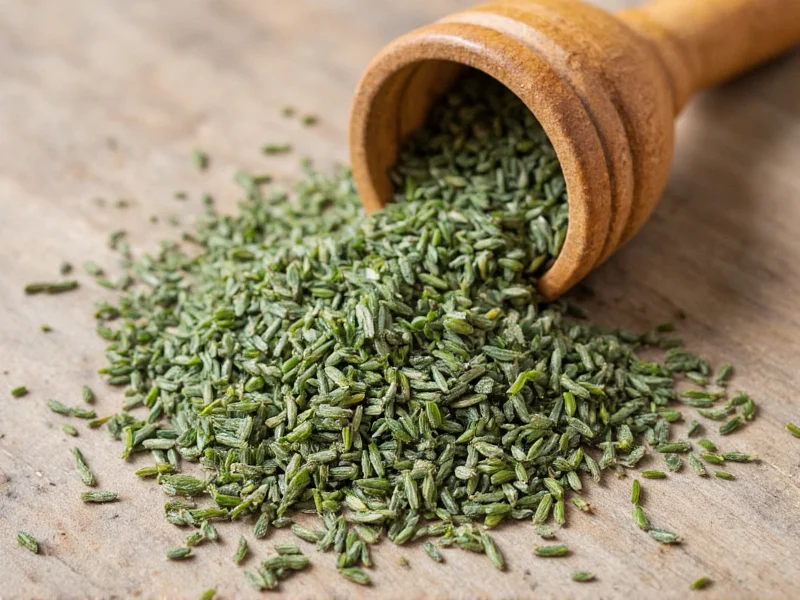The standard conversion ratio for dry thyme equivalent to fresh thyme is 1:3. This means 1 teaspoon of dried thyme equals 3 teaspoons (1 tablespoon) of fresh thyme. This measurement conversion accounts for the concentrated flavor in dried herbs compared to their fresh counterparts, which contain more moisture and have a milder taste profile.
Understanding Thyme Conversion Ratios for Perfect Cooking Results
When substituting dried thyme for fresh in recipes, getting the measurements right makes a significant difference in your final dish. The 1:3 ratio (1 part dried to 3 parts fresh) isn't arbitrary—it reflects the fundamental difference in moisture content and flavor concentration between these two herb forms.
Why Dried and Fresh Thyme Require Different Measurements
Dried thyme has had approximately 90% of its moisture removed during the dehydration process. This concentration means the essential oils and flavor compounds become more potent. Fresh thyme, with its higher water content, delivers a more subtle, grassy flavor that requires larger quantities to achieve similar flavor intensity.
Precise Measurement Guide for Thyme Substitution
For accurate cooking results, follow this detailed conversion chart when working with dry thyme equivalent to fresh thyme:
| Dried Thyme | Fresh Thyme Equivalent | Best For |
|---|---|---|
| ¼ teaspoon | ¾ teaspoon | Delicate sauces and dressings|
| ½ teaspoon | 1½ teaspoons | Soups and stews|
| 1 teaspoon | 1 tablespoon | Standard recipe substitution|
| 1½ teaspoons | 4½ teaspoons | Robust meat dishes|
| 1 tablespoon | 3 tablespoons | Long-cooking dishes
Practical Tips for Using Dried Thyme Instead of Fresh
Understanding dry thyme equivalent to fresh thyme is just the beginning. Consider these professional cooking tips:
- Add dried herbs earlier: Incorporate dried thyme at the beginning of cooking to allow time for rehydration and flavor development, while fresh thyme works best added in the last 10-15 minutes
- Crush before using: Rub dried thyme between your fingers before adding to release essential oils and maximize flavor
- Taste and adjust: Always taste your dish after incorporating substituted herbs, as individual palates and herb quality vary
- Consider dish type: For delicate dishes like fish or egg preparations, use 25% less dried thyme than the standard conversion suggests
When to Adjust the Standard Conversion Ratio
While the 1:3 dry thyme equivalent to fresh thyme ratio works for most applications, certain cooking scenarios require adjustments:
- Long-simmering dishes: Reduce dried thyme by 25% for recipes cooking longer than 2 hours, as flavors continue to concentrate
- Delicate preparations: Use a 1:2.5 ratio for sauces, dressings, or seafood where herb flavors should be subtle
- Older dried herbs: Increase dried thyme by 25% if your dried thyme is older than 6 months, as potency diminishes over time
- High-quality fresh thyme: Use slightly less fresh thyme (closer to 1:2.75 ratio) if harvesting from your own garden at peak season
Storage Differences Between Fresh and Dried Thyme
Proper storage affects both forms' potency and shelf life, which impacts your dry thyme equivalent to fresh thyme calculations:
- Fresh thyme: Store wrapped in slightly damp paper towel in airtight container in refrigerator (1-2 weeks freshness)
- Dried thyme: Keep in airtight container away from light and heat (6-12 months optimal potency)
- Freezing fresh thyme: Preserves flavor better than drying—frozen fresh thyme uses a 1:2.5 conversion ratio when substituting for dried
Professional Chef Insights on Thyme Substitution
Experienced chefs recommend these advanced techniques when working with dry thyme equivalent to fresh thyme:
- Bloom dried herbs: Briefly sauté dried thyme in oil before adding liquids to intensify flavor without bitterness
- Create herb oil: For critical dishes, make a quick herb oil by steeping fresh thyme in warm oil, then use the oil in place of dried thyme
- Layer flavors: Use 75% of the dried thyme measurement early in cooking, then finish with a small amount of fresh thyme for complexity
- Consider regional varieties: French thyme (thymus vulgaris) has stronger flavor than lemon thyme, requiring slight measurement adjustments
Common Mistakes to Avoid with Thyme Substitution
Many home cooks make these errors when converting between dry and fresh thyme:
- Using equal measurements (1:1 ratio) resulting in overly strong, bitter flavors
- Adding dried thyme at the same stage as fresh, missing optimal flavor development
- Not accounting for age of dried herbs, using stale product that lacks potency
- Substituting without considering the dish's cooking time and temperature
- Measuring dried herbs without first breaking up clumps, leading to inconsistent results











 浙公网安备
33010002000092号
浙公网安备
33010002000092号 浙B2-20120091-4
浙B2-20120091-4